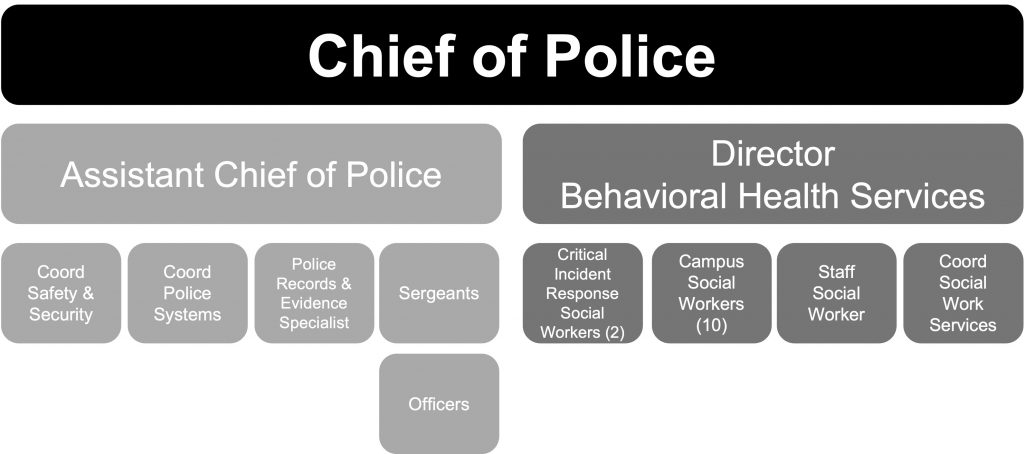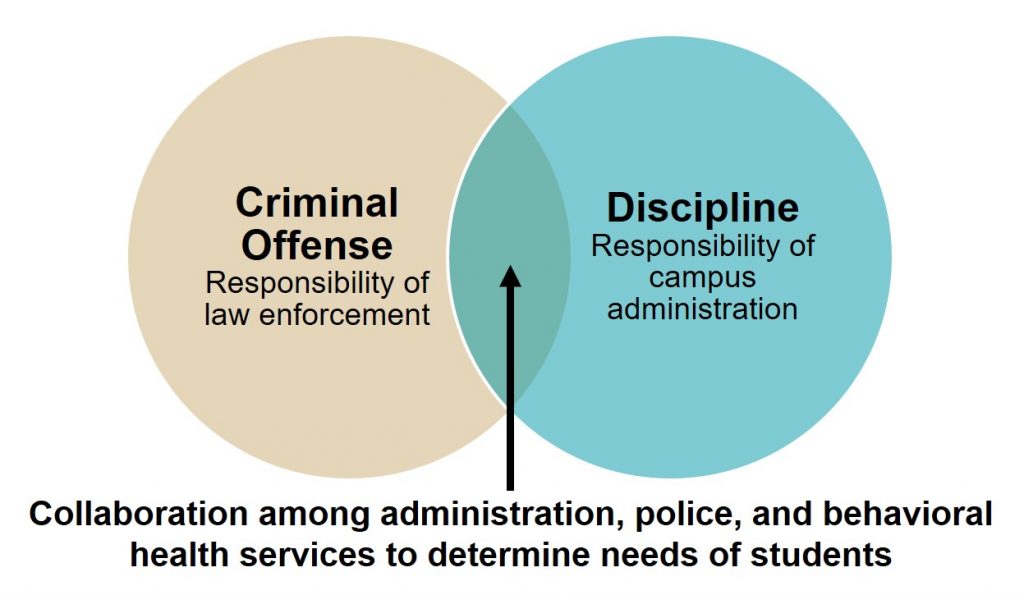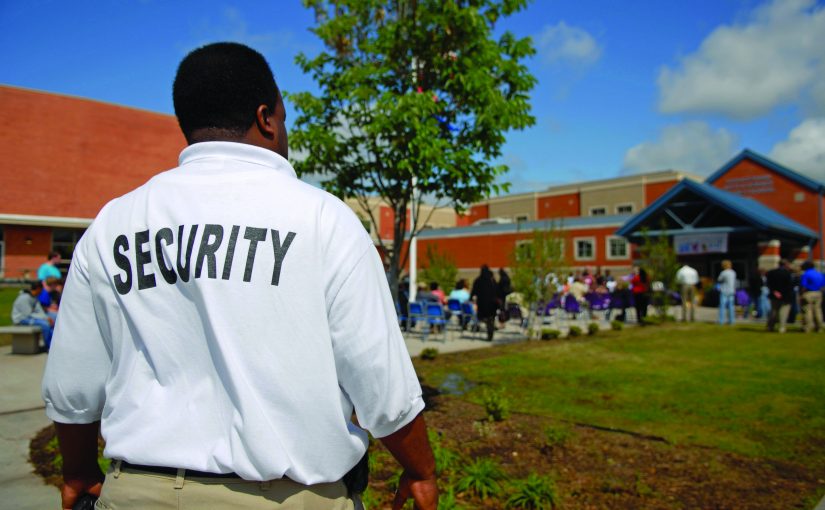Policing for K–12 schools is different from other forms of policing. While in the end, all police departments are made up of police officers who enforce the law, the approach to policing students must differ from traditional municipal policing.
The practice of school policing has evolved over the years. There has been an increasing tension between the dual responsibilities of enforcing the law while also nurturing the educational journey of some of the most vulnerable members of society. The news is constantly showing this tension with publications on the school-to-prison pipeline, disparate impacts on students of color, and the need to protect schools from threats like active shooters. Schools are left to make decisions on school policing that attempt to address these sometimes-conflicting priorities.
Round Rock ISD Police Department
The Round Rock Independent School District (ISD) is a suburban school district outside of Austin, Texas. The district educates 47,000 students each year. In 2017, the district was informed that its traditional student resource officer (SRO) program, staffed by three different local agencies, would be dissolved by 2021 because of foreseen staff shortages.
Round Rock ISD had to consider how to fill the gap. A safety and security task force was formed that included parents, community members, and experts in the area. Their task was to look at the different options available to the district and present those options to the school board who would make the final decision. After a year of work, the committee members made their recommendations to the Round Rock ISD School Board, and the board determined that the best option was for the district to form its own police department.
In addition to the formation of the Round Rock ISD Police Department, the safety and security task force brought forward three other related topics to the Round Rock ISD School Board: (1) the need for a robust behavioral health services department, including social workers; (2) the need to consider the emotional and mental needs of students; and (3) the need to focus on equity while developing the new police department. The board agreed with the task force’s recommendations, and, in August 2020, the first chief of police was hired—and the new department started to develop.
From the start of the Round Rock ISD Police Department, a different approach to school policing was taken. This was partly based on the recommendations of the safety and security task force, but it was also due in part to the staff who were hired to help develop the department. The director of behavioral health services was hired in February 2020 , and the collaboration between the chief of police and the director of behavioral health services was instrumental in forming the direction of the department. Behavioral health services merged with the newly created police department, and the director of behavioral health became an integral part of the police department. The combination of police and behavioral health was the foundation of rethinking school policing. While officers were being hired, a team of social workers were also joining the department.
| Round Rock ISD Police Department’s Guiding Pillars | |
|
|
During its formation, it was clear that four main areas were guiding the work of the police department: safety and security, equity, behavioral health, and student advocacy. These areas quickly became the pillars of the department. Policy was written with these pillars in mind, and interview questions for the incoming police officers and social workers were based on these areas of focus.
| Figure 1: Organizational Chart of the Round Rock ISD Police Department |
 |
Not only did the pillars guide the formation of the department, but safety and security, equity, behavioral health, and student advocacy also continue to be at the core of the work done daily. In two and a half years, the Round Rock ISD Police Department has evolved into a respected model in school policing because of the unique way it delivers policing services.
Safety and Security
When a school district forms a police department, the number one mission is to provide safety and security to its campuses. Families send students to school each day, trusting the district to provide a safe environment. The Round Rock ISD Police Department focuses on prevention with regard to safety. The department regularly revisits and revises its procedures and performs training to advance the priority of keeping students and staff safe. The wrap-around preventive and responsive safety services include
- improving student academic achievement and well-being by providing mental health services,
- assessing and improving physical and environmental safety,
- practicing de-escalation strategies, and
- partnering with area law enforcement and other social services to promote public safety in the community.
In addition, the Round Rock ISD Police Department believes school safety is the responsibility of the entire community. Police officers work with campus administrators and meet regularly to discuss safety concerns that arise. The department partners with the Round Rock Council of PTAs to provide information to families on current safety topics (e.g., fentanyl, vaping). Quarterly newsletters are also emailed to all stakeholders to ensure everyone is informed and on the same page.
Finally, the focus on safety and security allows Round Rock ISD to implement training for staff and officers to not use “scare tactics” on a student with behavior concerns. This creates the opportunity where the police officers can become role models and mentors to the students. It means officers get to know students and form trusting relationships. Instead of being seen as enforcers, officers are seen as a source of support and a safe adult for students to turn to.
Equity
The Round Rock ISD Police Department focuses on equity by striving to meet the individual needs of each student they encounter. As one officer stated, “Equality is giving every student a pair of shoes; equity is giving each student a pair of shoes that fit.” Because Round Rock ISD has its own police department, the department gets to choose how to spend the extra time and resources that are needed to meet the individual needs of each student.
So much of the behind-the-scenes equity work in the police department comes in the form of training. Officers and social workers are provided with opportunities to not only learn about different student populations, but also to hear from experts on how best to interact and work with these students. For example, one recent training focused on how to interact with students who have differing special needs. While the training was informational, it also provided opportunities for staff to hear directly from individuals with a variety of different backgrounds.
In addition, the department applies a trauma-informed lens to all activities. Trauma can have a substantial impact on students resulting at times in what is normally seen as problematic behavior. Instead of focusing on the behavior that is seen, Round Rock ISD Police Department aims to discover what is behind the behavior.
Behavioral Health
The impact of COVID-19 over the last few years has negatively impacted students’ mental health; the rates of depression, anxiety, and suicide among students have been steadily rising for over a decade.1 In December 2021, the U.S. Surgeon General released an advisory on protecting youth mental health emphasizing the crisis point the United States faces in caring for the mental health of students.2 Because of the prevalence of mental health concerns of students, it is critical that school-based police departments not only acknowledge this reality, but also take a proactive stance in the way to approach the topic.
What is different in Round Rock ISD is that police officers and social workers are in the same department, working together side by side.
Many school districts across the United States have police departments, and many school districts have social workers. What is different in Round Rock ISD is that police officers and social workers are in the same department, working together side by side. Because of this partnership, students’ mental health concerns are always a primary consideration. Instead of officers waiting to be called during the mental health crisis of a student, officers and social workers are in collaboration to provide proactive assistance to students when the need arises.
The partnership between officers and social workers is successful because they are in the same department. The mission and goals are the same for both groups, and all are on the same path. Mutual trust is essential to the success of this model. It is developed between the two parts of the department because there is trust at the top between the chief of police and the director of Behavioral Health Services. Decisions are made in collaboration with each party contributing expertise from their area and not crossing over into the other’s lane. Social workers do not tell officers how to police, and officers count on social workers to be the mental health experts.
The department depends not only on social workers to support the mental health needs of students, but on therapy dogs to assist as well. Social workers and police officers serve as handlers for the dogs. Dogs can assist in de-escalating students in crisis, providing emotional support after traumatic events, and proactively working with students experiencing early symptoms of anxiety.
One critical program that has come under the direction of the police department, and specifically Behavioral Health Services, is behavioral threat assessment and management. Behavioral threat assessment and management is done in school districts across the United States, but in Round Rock ISD, it was decided to approach the process in a way that not only mitigates threats and ensures safety and security, but also intervenes as early as possible with behavioral health services for the student who is considered at risk of future violent behaviors.
Too often threats are considered only after a student is far along the pathway to violence. The Round Rock ISD Police Department is leading the way to change the narrative in the district and to start considering early warning signs by a student. School districts get caught in a cycle of overly focusing on addressing crises and being reactive. The Round Rock ISD Police Department takes a different, and arguably better, approach to lowering risks by emphasizing the importance of both paying attention to low-level concerns and responding with support and resources.
Student Advocacy
While the safety and security of students and staff are important for any school district police department, in Round Rock ISD, student advocacy is just as important. Being a student advocate looks different in each interaction and for each individual, depending on the situation. What is consistent with each situation is that police officers and social workers advocate for what is in the best interest of the student. This spans from deciding if a student will be arrested to ensuring families have food to eat.
The main objective as a student advocate is to make every effort to keep a student out of the criminal justice system. Round Rock ISD Police Department’s approach is that just because a student can be arrested does not mean the student should be arrested. Instead of relying on criminal justice to punish juvenile behaviors, other alternatives are sought to make sure students find a better path forward.
Student advocacy relies upon the other three pillars: safety and security, equity, and behavioral health. Without these other pillars, student advocacy is not possible. Police officers and social workers can truly understand and advocate for each student by treating them as individuals and looking at what each student needs.
Officers should never be involved in the discipline of students—that is an administrative responsibility. One of the biggest opportunities for advocacy happens at the intersection between what could either be considered a discipline situation or a criminal offense at a school. If the offense can be handled with school discipline and support provided to the student (e.g., mental health counseling, social services, drug counseling), it should be—and officers advocate for that outcome.
| Figure 2: Intersection of Criminal Offense & Discipline |
 |
Conclusion
Round Rock ISD’s approach to school policing developed from the needs of students, concerns of the community, and from the input of staff that have led the effort. The department is relatively young, but it has already made an impact with its unique model. Most importantly, students’ lives have been positively impacted because of the approach. Round Rock ISD’s chief of police says the work has just started and there are so many exciting opportunities to continue to improve the model.
Each year, the needs of the students in Round Rock ISD change, and the police department, supported by its four pillars, will continue to meet those needs. 🛡
Notes:
1Daniel Eisenberg et al., The Healthy Minds Study: 2021–2022 Data Report (Healthy Minds Network, 2023).
2 Office of the Surgeon General, Protecting Youth Mental Health: The U.S. Surgeon General’s Advisory (Washington, D.C.: U.S. Department of Health and Human Services, 2021).
Please cite as
Dennis Weiner and Amy Grosso, “Rethinking School Policing: How Round Rock ISD Is Revolutionizing the Model,” Police Chief Online, June 7, 2023.



